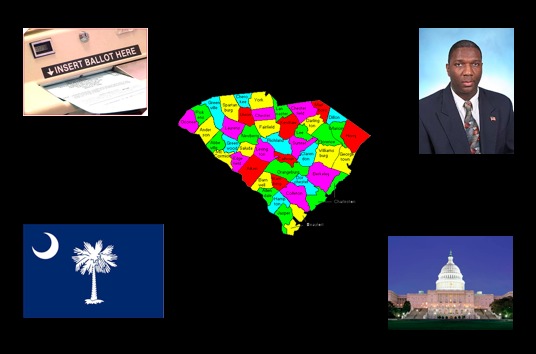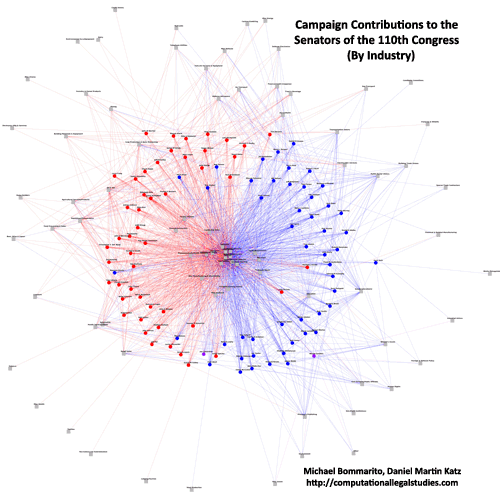Click above to access visual and for the Full Report entitled Estimating U.S. Government Subsidies to Energy Sources: 2002-2008 click here! [HT: Barry Ritholtz @ The Big Picture]
Tag: senate
Roundup of Coverage: Alvin Greene and the South Carolina Senate Primary

This is a bit far afield for the typical things we highlight on this blog. However, we thought this was an interesting story. Both Tom Schaller (538.com) and John Sides (The Monkey Cage) offer good initial analysis of the outcome. The other three references are simply offered for those seeking background information on the controversy.
Something Fishy in the South Carolina Primary (Tom Schaller @ 538.com),
Did Alvin Greene Win Because of Ballot Order? Because of Race? (John Sides @ The Monkey Cage)
In South Carolina, Greene is Mystery Man Despite Winning Democratic Senate Nod (Washington Post)
Keith Olbermann Interview of Alvin Greene (YouTube)
Alvin Greene is “Someone’s Plant,” Should be Investigated, Clyburn Says (CBS News.com)
H.R. 4872 Word Cloud
With the passage of H.R. 4872 in the House last night, our previous research on the relative size of H.R. 3962 has been in high demand. While we are not yet prepared to run similar calculations for H.R. 4872, at first glance we can say – as passed, H.R. 4872 is marginally longer H.R. 3200 and nearly 20% longer than H.R. 3962.
We have created the word cloud below … it is mainly just for fun. However, one interesting thing that jumps out from the cloud is the prevalence of the word “secretary.” Indeed, this may indicate the legislation provides a non-trivial amount of discretion to the relevant various administrative agencies.

160,000 Hours of C-Span Coverage at Your Finger Tips
As reported in the NY Times … roughly 160,000 hours of C-SPAN coverage is going live for your consumption. Yet another example that the Era of Big Data is upon us!
OpenSecrets Open Data! – Visualizing the Publicly Traded Assets of Senators in 2007
OpenSecrets.org went open with their data today. In honor of this very significant act and its ramifications on future government transparency, I’ve decided to produce a quick visualization to answer a question I’ve long been intrigued by – the publicly traded holdings of Senators. One good proxy to this question is the Personal Financial Disclosure data released today by Open Secrets. In the words of Open Secrets,
Any legal ownership a person has in a company or property is classified as an asset, including brokerage accounts, corporate bonds and stocks. For the most part, lawmakers seem to have a stake in big-name, recognizable companies and properties. They need to report only assets worth more than $1,000 at the end of the calendar year, or producing more than $200 of income. (One note about mutual funds: Filers are not required to provide detail on funds’ individual holdings.) Any purchases, sales or exchanges of assets during the year of more than $1,000 must be disclosed as transactions. Reporting the value of a primary residence, unless it produces income, is not required.
This visual represents a very rough cut of this data for the holdings of Senators in 2007. As is often the case with real form data, there are inconsistencies across the data set. Ideally, one could simply use the asset’s description, which would accurately report the assets held in an account. However, as these are not always provided, the “asset source” is used in their absence. When combined with the mutual fund issues mentioned above, blind trust reporting, and these possible transcription errors, there is a compelling case against strict interpretation of this visual. In any case, enjoy the visual, and again, thanks to Open Secrets for their monumental move forward!
Senators of the 110th Congress Take 2-Contributions by Industry/Sector
To view the full image, please click here.
This represents a deeper cut on campaign contributions to the Senators of 110th Congress. Again, we rely upon data from the Center for Responsive Politics. The CRP aggregates contribution data up to the industry or economic sector. Thus, as before, we adopt their classification scheme and methodology herein. While aggregating to the industry/sector level removes the degree of specificity we offered in our earlier post, it provides a cleaner representation for the graph. For those interested in the other chamber, click here for the House of Representatives.
Click on the picture above and it will take you to our flash where you can zoom in and read the labels.
As you review the graph, please consider the following:
(1) Industries locate in the center of the graph because they provide significant funding to both Democrats and Republicans.
(2) Industries which generally only fund one political party are located toward the respective red/blue boundary. For example, it is hardly surprising to observe the location of “Oil and Gas” relative to “Environmental” groups.
(3) It is important to note that we do not impose the partisan separation or the placement of party outliers apparent in the image. Rather, the algorithm places Red Senators in Blue Territory and Blue Senators in Red Territory because they receive significant sums from industries who typically fund the opposing party. For example, consider Senator Olympia J Snowe (R-ME) who is typically characterized as a moderate Republican. Since she receives money from more industries that typically fund Democrats than Republicans, she is placed in Blue Territory by the algorithm.
(4) It is important not to over read the position of Senator Herb Kohl (D-WI). Over the relevant time window, Senator Kohl received 94% of his resources through self-financing.
Visualizing the Campaign Contributions to Senators in the 110th Congress — The TARP EDITION (Documentation for the Network)
University of Michigan
Center for the Study of Complex Systems
Department of Political Science
BASIC OVERVIEW:
110th Congress = January 3, 2007 – January 3, 2009
100 Members of the United States Senate
Click Here for the House of Representatives
BASIC RULE:
Squares (Institutions) Introduce Money into the System and Circles (Senators) Receive Money.
DATA OVERVIEW:
Using recently published data on campaign contributions collected by the Federal Election Commission and aggregated by the Center for Responsive Politics at http://www.opensecrets.org, our visualizations track large money donations to members of the 110th Congress over the 2003-2008 window.
Given that some senators resign or lose reelection, a subset of the senators of the 110th Congress have served less than the full 2003-2008 window. While this imposes some comparability issues, many of these new members faced challenging races and thus attracted significant sums of money.
It is important to note that most of these organizations did not directly donate. Rather, as noted by the Center for Responsive Politics “the money came from the organization’s PAC, its individual members or employees or owners, and those individuals’ immediate families. Organization totals include subsidiaries and affiliates. Of course, it is impossible to know either the economic interest that made each individual contribution possible or the motivation for each individual giver. However, the patterns of contributions provide critical information for voters, researchers and others.” The Center describes its methodology here http://www.opensecrets.org/politicians/method_pop.php. We strike a tradeoff between information overload and incomplete disclosure. To provide for an optically tractable view of the top contributions, we impose the limiting requirement that to be included in our tally a given group’s contribution must fall within a given senator’s top contributor list. For a first cut on the data, we believe this reaches an appropriate balance. However, in subsequent work we plan to go much deeper and probe a much larger set of contribution information.
CONTRIBUTORS & CONTRIBUTIONS:
1,050 of the Donors are captured in the Graph.
Total Recorded Donations Introduced into the System by these Entities Total to $94, 138,917.
(1) SIZING of the SENATOR NODES — Each Circular node representing a U.S. Senator is sized according the amount of incoming donations. Thus, larger U.S. Senator nodes are the recipients of larger sums of money while the smaller nodes received smaller amounts of money.

NOTE ON SELF-FINANCING — Some candidates use personal funds to finance their campaigns. For example, Senator Herb Kohl (D-WI) spent $5,922,759 of which $5,575,000 (94%) came from his personal assets. In this respect, Senator Kohl has a significant “self-loop” but is sized very small because he accepts very little outside monies.
(2) COLORING of the SENATOR NODES — Each node representing a US Senator is colored according their Political Party. Using popular convention, we color members of the Republican Party as Red, members of the Democratic Party as Blue and Independents as Purple. For the 110th Congress, there are two Independents—Bernie Sanders (I- VT), Joe Lieberman (I- CT), respectfully.

(3) COLORING of the INSTITUTIONAL NODES — Each square node represents institutions who are top contributors to at least one Senator in the 110th Congress. The full graph contains 1,050 institutions of two separate classes. Green institutions are either primary TARP recipients or now components of primary recipients of resources under the Troubled Asset Relief Program. For example, we color Wachovia as Green even though they are now owned by Wells Fargo, a TARP recipient.

(4) SIZING of the INSTITUTIONAL NODES — Each square node representing a TARP or Non-TARP institution is sized according their relative financial contribution to the over all system. Thus, larger institutions make larger contributions and smaller institutions make smaller contributions.

(5) SIZING of the CONNECTIONS — Each Connection (Arc) between an Institution and a Senator is sized according to the amount of money flowing through a connection. Darker connections represent larger flows of money while lighter connections represent smaller amounts of money.

(6) COLORING of the CONNECTIONS — Each connection representing a campaign contribution from an institution to a US Senator is colored according to partisan affiliation of the receiving senator. Using popular convention, we color members of the Republican Party as Red, members of the Democratic Party as Blue and Independents as Purple. For the 110th Congress, there are two Independents—Bernie Sanders (I- VT), Joe Lieberman (I- CT), respectfully.

(7) STRUCTURE OF THE GRAPH — The Graph is Visualized Using the Kamada-Kawai Visualization Algorithm. This is an automated spring embedded, force directed placement algorithm often used in the network science literature to visualize graphs of this size.
(8) ACKNOWLEDGEMENTS — We thank Rick Riolo, Jon Zelner, Carl Simon, Scott Page and the Center for Responsive Politics for their comments, contributions and/or data.






